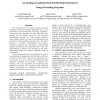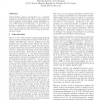180 search results - page 12 / 36 » Reversible Computation and Reversible Programming Languages |
ASE
1998
13 years 7 months ago
1998
The process of understanding a source code in a high-level programming language involves complex computation. Given a piece of legacy code and a library of program plan templates, ...
PASTE
2005
ACM
14 years 1 months ago
2005
ACM
Program analysis has many applications in software engineering and high-performance computation, such as program understanding, debugging, testing, reverse engineering, and optimi...
WCRE
2003
IEEE
14 years 1 months ago
2003
IEEE
Our research goal is to retarget image processing programs written in sequential languages (e.g., C) to architectures with data-parallel processing capabilities. Image processing ...
ASE
2007
13 years 8 months ago
2007
Knowing which associations are compositions is important in a tool for the reverse engineering of UML class diagrams. Firstly, recovery of composition relationships bridges the ga...
COMPSAC
2000
IEEE
14 years 12 days ago
2000
IEEE
Understanding program dependencies in a computer program is essential for many software engineering tasks such as program understanding, testing, debugging, reverse engineering, a...


